美国文学16讲-作品赏析
- 格式:doc
- 大小:22.00 KB
- 文档页数:4

美国文学教程:欣赏与评析
美国文学是美国文化的重要组成部分,它深刻地反映了美国的历史、社会、文化和政治。
美国文学教程可以帮助学生了解美国文学的不同历史时期,欣赏和评析美国文学作品,以及学习美国文学的主要流派和文体。
首先,美国文学教程应该介绍美国文学的历史渊源,从美国的早期历史到现代文学,介绍美国文学的发展历程,以及美国文学的特点。
学生可以学习到美国文学的不同流派,如自然主义、现实主义、浪漫主义等,以及它们的特点。
其次,美国文学教程应该介绍美国文学的主要作品,包括小说、散文、诗歌、戏剧等,以及美国文学的著名作家,如爱德华·詹姆斯、梭罗、海明威等。
学生可以学习到美国文学作品
的欣赏和评析方法,以及美国文学作品的主要主题和内容。
最后,美国文学教程应该教授学生如何运用文学手法,如讽刺、比喻、拟人等,以及如何分析文学作品的结构、情节、人物和主题。
学生可以学习到如何通过文学作品来反映社会现实,以及如何用文学的方式抒发自己的情感。
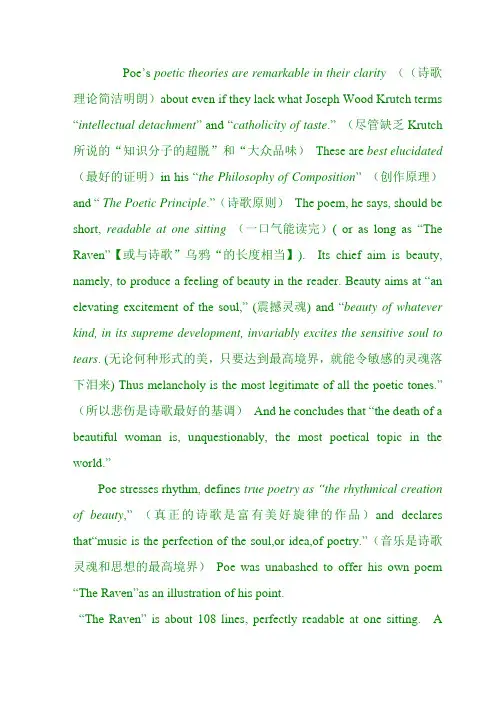
Poe’s poetic theories are remarkable in their clarity((诗歌理论简洁明朗)about even if they lack what Joseph Wood Krutch terms “intellectual detachment” and “catholicity of taste.” (尽管缺乏Krutch 所说的“知识分子的超脱”和“大众品味)These are best elucidated (最好的证明)in his “the Philosophy of Composition” (创作原理)and “ The Poetic Principle.”(诗歌原则)The poem, he says, should be short, readable at one sitting(一口气能读完)( or as long as “The Raven”【或与诗歌”乌鸦“的长度相当】). Its chief aim is beauty, namely, to produce a feeling of beauty in the reader. Beauty ai ms at “an elevating excitement of the soul,” (震撼灵魂) and “beauty of whatever kind, in its supreme development, invariably excites the sensitive soul to tears. (无论何种形式的美,只要达到最高境界,就能令敏感的灵魂落下泪来) Thus melancholy is the most legitimate of all the poetic tones.” (所以悲伤是诗歌最好的基调)And he concludes that “the death of a beautiful woman is, unquestionably, the most poetical topic in the world.”Poe stresses rhythm, defines true poetry as “the rhythmical creation of beauty,” (真正的诗歌是富有美好旋律的作品)and declares that“music is the perfection of the soul,or idea,of poetry.”(音乐是诗歌灵魂和思想的最高境界)Poe was unabashed to offer his own poem “The Raven”as an illustration of his point.“The Raven”is about 108 lines, perfectly readable at one sitting. Asense of melancholy over the death of a beloved beautiful young woman pervades the whole poem: the portrayal of a young man grieving for his lost Lenore, (早逝的美丽女友Lenore )his grief being turned to madness under the steady one-word repetition of the talking bird introduced right at the beginning of the poem:Once upon a midnight dreary, while I pondered, weak and weakry.Over many a quint and curious volume of forgotten lore.While I nodded, nearly napping, suddenly there came a tapping,As of some one rapping, rapping at my chamber door."'Tis some visitor," I muttered, "tapping at my chamber door--Only this, and nothing more."After he sees the bird, its response -- or its imagined one一“nevermore"–keeps breaking upon the young man’s psychic wound ruthlessly and ceaselessly as do the waves on the sea shore until his depression reaches its breaking point:And the raven, never flitting, still is sitting, still is sittingOn the pallid bust of Pallas just above my chamber door;And his eyes have all the seeming of a demon that is dreaming,And the lamp-light o' er him streaming throve his shadow on the floor;And my soul from out chat shadow that lies floating on the floorShall be lifted-nevermore!The young man, a neurotic on the brink of a mental collapse, (精神几近崩溃)outpours his sorrow in his semi-sleep(半梦半醒之间)on the appearance of the bird. Poetic imagination externalizes itself(诗歌的想象力表现在…)in the phantom of a bird(幻象中的小鸟)and intermingles with it to enhance the effect of tbe tragedy of the bereavement .(失去挚爱的悲剧)It is good to note that Poe’s poems are heavily tinted in a dreamy, hallucinatory color. (Poe 的诗歌中具有一种浓烈的梦境和幻觉的色彩)“The Raven”is a good example as the narrator is in a state of semi-stupor. (神志几近不清的状态)In addition, Poe insists on an even metrical flow in versification.(主张运用规则的韵律创作)“The Raven”is a marvel of regularity: W. L.Werner records that, of its 719 complete feet, (全诗有719个音步),705 are perfect trochees, (其中705个是完全的抑扬格)ten doubtful trochees, (十个勉强可算是抑扬格)and only four clearly dactyls.(只有四个是强弱格)Poe rarely allows himself twenty-five percent of irregular feet as is found in “Israfel”. (Poe 几乎不会让诗中出现四分之一以上的不规则音步,就像在诗歌Israfel里一样)For the sake of regularity in rhythm, Poe disapproves of the use of archaisms, contractions, inversions, and similar devices.(Poe反对使用古体、缩写、倒置等技法)“The Raven” is thus aperfect illustration of his theory on poetry.The RavenOnce upon a midnight dreary, while I pondered, weak and weakry. Over many a quint and curious volume of forgotten lore.While I nodded, nearly napping, suddenly there came a tapping, As of some one rapping, rapping at my chamber door."'Tis some visitor," I muttered, "tapping at my chamber door--Only this, and nothing more."Ah, distinctly I remember it was in the bleak December,And each separate dying ember wrought its ghost upon the floor. Eagerly I wished the morrow; -vainly I had tried to borrowFrom my books surcease of sorrow -sorrow for the lost Lenore- For the rare and radiant maiden whom the angels name Lenore-Nameless here for evermoreAnd the silken sad uncertain rustling of each purple curtain Thrilled me-filled me with fantastic terrors never felt before;So that now, to still the beating of my heart, I stood repeating" ' Tis some visitor entreating entrance at my chamber door- Some late visitor entreating entrance at my chamber door;-This it is and nothing more.Presently my soul grew stronger; hesitating then no longer, "Sir," said I, "or Madam, truly your forgiveness I implore;But the fact is I was napping, and so gently you came rapping,And so faintly you came tapping, tapping at my chamber door,That I scarce was sure I heard you"--here I opened wide the door;Darkness there, and nothing more.Deep into that: darkness peering, long I stood there wondering, fearing Doubting, dreaming dreams no mortal ever dared to dream before; But the silence was unbroken, and the darkness gave no token,And the only word there spoken was the whispered word, "Lenore!" This I whispered, and an echo murmured back the word, " Lenore! " Merely this, and nothing more.Then into the chamber turning, all my soul within me burning,Soon I heard again a tapping somewhat louder than before. "Surely," said I, "surely that is something at my window lattice;Let me see, then, what thereat is, and this mystery explore-Let my heart be still a moment and this mystery explore;'Tis the wind, and nothing more!Open here I flung the shutter, when, with many a flirt and flutter.In there stepped a stately raven of the saintly days of yore;Not the least obeisance made he; not an instant stopped or stayed he; But, with mien of lord or lady, perched above my chamber door- Perched upon a bust of Pallas just above my chamber door-Perched, and sat, and nothing more.Then this ebony bird beguiling my sad fancy into smiling,By the grave and stern decorum of the countenance it wore,"Though thy crest be shorn and shaven, thou," I said, "art sure no craven, Ghastly grim and ancient raven wandering from the Nightly shore-Tell me what thy lordly name is on the Night ' s Plutonian shore!Quoth the raven, "Nevermore. "Much I marveled this ungainly fowl to hear discourse so plainly, Though its answer little meaning-little relevancy hore;For we cannot help agreeing that no sublunary beingEver yet was blessed with seeing bird above his chamber door-Bird or beast upon the sculptured bust above I us chamber door,With such mime as "Nevermore.“But the raven, sitting lonely on the placid bust, spoke onlyThat one word, as if his soul in that ill~ word he did outpour. Nothing farther then he uttered-not a feather then he fluttered-Till I scarcely more than muttered, "Other friends have flown before- On the morrow he will leave me, as my hopes have flown before. " Quoth the raven, "Nevermore. "Wondering at the stillness broken by reply so aptly spoken, "Doubtless," said I, "what it utters is its only stock and store," Caught from some unhappy master whom unmerciful Disaster Followed fast and followed fastel-so, when Hope he would adjure, Stern Despair returned, instead of the sweet Hope he dared adjure-That sad answer, "Nevermore!"But the raven still beguiling all my sad soul into smiling,Straight I wheeled a cushioned seat in front of bird, and bust, and door ;Then upon the velvet sinking, I betook myself to linkingFancy unto fancy, thinking what this ominous bird of yore-What this grim, ungainly, ghastly, gaunt, and ominous bird of yoreMeant in croaking "Nevermore. "This I sat engaged in guessing, but no syllable expressingTo the fowl whose fiery eyes now burned into my bosom's core;This and more I sat divining, with my head at ease recliningOn the cushion's velvet lining that the lamplight gloated o'er,But whose velvet violet lining with the lamplight gloating o'er,She shall press, ah, nevermore!Then, methought, the air grew denser, perfumed from an unseen censer Swung by angels whose faint foot-falls tinkled on the tufted floor. "Wretch," I cried, "thy God hath lent thee-by these angels he hath sent th eeRespite-respite and Nepenthe from thy memories of Lenore!Let me quaff this kind Nepenthe and forget this lost Lenore!"Quoth the raven, "Nevermore. ""Prophet!" said I, "thing of evil! -prophet still, if bird or devil! - Whether Tempter sent, or whether tempest tossed thee here ashore, Desolate, yet all undaunted, on this desert land enchanted-On this home by Horror haunted-tell me truly, I implore-Is there-is there balm in Gilead?-tell me-tell me, I implore!"Quoth the raven, "Nevermore. ""Prophet!" said I, "thing of evil! -prophet still, if bird or devil!By that Heaven that bends above us-by that God we both adore-Tell this soul with sorrow laden if, within the distant Aidenn ,It shall clasp a sainted maiden whom the angels name Lenore-Clasp a rare and radiant maiden whom the angels name Lenore.Quoth the raven, "Nevermore. ""Be that word our sign of parting, bird or fiend!" I shrieked, upstarting- "Get thee back into the tempest and the Night's plutonian shore!Leave no black plume as a token of that lie thy soul hath spoken! Leave my loneliness unbroken! -quit the bust above my door!Take thy beak from out my heart, and take thy form from off my door! " Quoth the raven, "Nevermore. "And the raven, never flitting, still is sitting, still is sittingOn the pallid bust of Pallas just above my chamber door;And his eyes have all the seeming of a demon that is dreaming,And the lamp-light o' er him streaming throve his shadow on the floor; And my soul from out chat shadow that lies floating on the floorShall be lifted-nevermore!* The RavenOnce upon a midnight dreary, while I pondered, weak and weakry,Over many a quint and curious volume of forgotten lore,While I nodded, nearly napping, suddenly there came a tapping, As of some one rapping, rapping at my chamber door.“Tis some visitor," I muttered, "tapping at my chamber door ——Only this, and nothing more."有一天阴沉的半夜时分,当我疲乏烦闷,面对一堆古籍奇书,想把失传的奥秘揭开,当我打着盹几乎睡着,忽听得一声剥啄,仿佛有人轻轻敲着,轻敲在我的房门外。

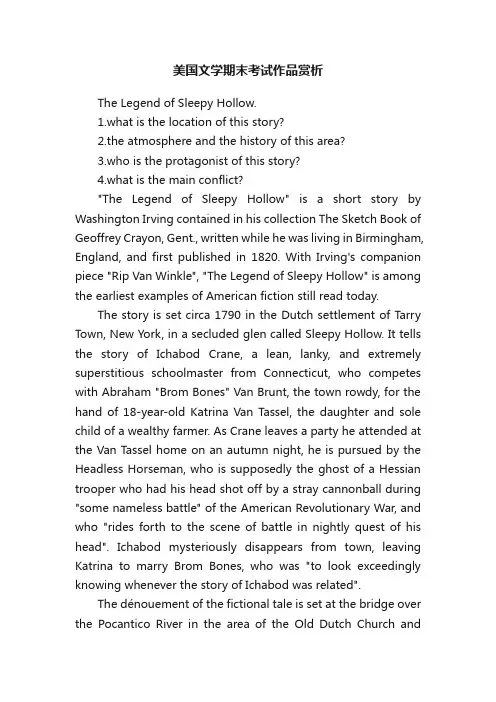
美国文学期末考试作品赏析The Legend of Sleepy Hollow.1.what is the location of this story?2.the atmosphere and the history of this area?3.who is the protagonist of this story?4.what is the main conflict?"The Legend of Sleepy Hollow" is a short story by Washington Irving contained in his collection The Sketch Book of Geoffrey Crayon, Gent., written while he was living in Birmingham, England, and first published in 1820. With Irving's companion piece "Rip Van Winkle", "The Legend of Sleepy Hollow" is among the earliest examples of American fiction still read today.The story is set circa 1790 in the Dutch settlement of Tarry Town, New York, in a secluded glen called Sleepy Hollow. It tells the story of Ichabod Crane, a lean, lanky, and extremely superstitious schoolmaster from Connecticut, who competes with Abraham "Brom Bones" Van Brunt, the town rowdy, for the hand of 18-year-old Katrina Van Tassel, the daughter and sole child of a wealthy farmer. As Crane leaves a party he attended at the Van Tassel home on an autumn night, he is pursued by the Headless Horseman, who is supposedly the ghost of a Hessian trooper who had his head shot off by a stray cannonball during "some nameless battle" of the American Revolutionary War, and who "rides forth to the scene of battle in nightly quest of his head". Ichabod mysteriously disappears from town, leaving Katrina to marry Brom Bones, who was "to look exceedingly knowing whenever the story of Ichabod was related".The dénouement of the fictional tale is set at the bridge over the Pocantico River in the area of the Old Dutch Church andBurying Ground in Sleepy Hollow. The characters of Ichabod Crane and Katrina Van Tassel may have been based on local residents known to the author. The character of Katrina is thought to have been based upon Eleanor Van Tassel Brush, in which case her name is derived from that of Eleanor's aunt Catriena Ecker Van Tessel.Although Irving knew an army colonel named Ichabod Crane from Staten Island, New York (who was also once the Commanding Officer of Lieutenant Stonewall Jackson), the character in "The Legend" may have been patterned after Jesse Merwin, who taught at the local schoolhouse in Kinderhook, further north along the Hudson River, where Irving spent several months in 1809.the wild honey suckle 的分析《野金银花》是Freneau在南卡罗莱纳州查尔斯顿散步时,看到一簇幽生的金银花,于是便有感而发,将这首短诗一气呵成。
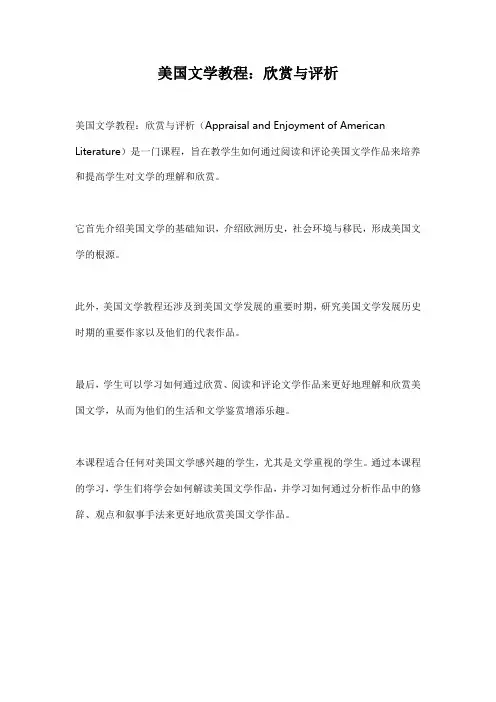
美国文学教程:欣赏与评析
美国文学教程:欣赏与评析(Appraisal and Enjoyment of American Literature)是一门课程,旨在教学生如何通过阅读和评论美国文学作品来培养和提高学生对文学的理解和欣赏。
它首先介绍美国文学的基础知识,介绍欧洲历史,社会环境与移民,形成美国文学的根源。
此外,美国文学教程还涉及到美国文学发展的重要时期,研究美国文学发展历史时期的重要作家以及他们的代表作品。
最后,学生可以学习如何通过欣赏、阅读和评论文学作品来更好地理解和欣赏美国文学,从而为他们的生活和文学鉴赏增添乐趣。
本课程适合任何对美国文学感兴趣的学生,尤其是文学重视的学生。
通过本课程的学习,学生们将学会如何解读美国文学作品,并学习如何通过分析作品中的修辞、观点和叙事手法来更好地欣赏美国文学作品。
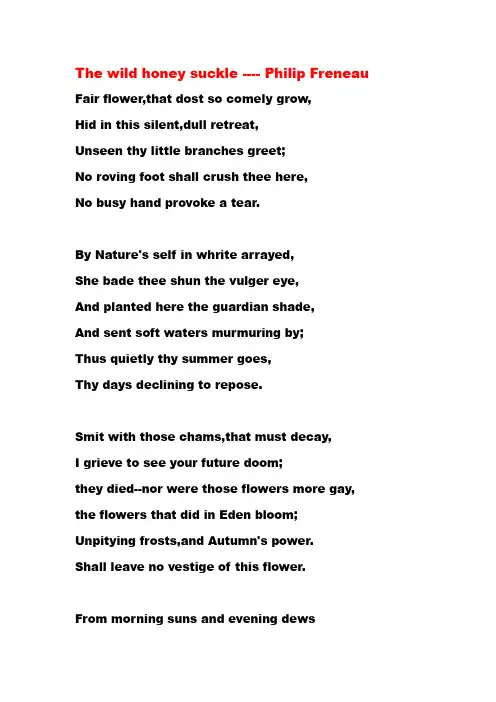
The wild honey suckle ---- Philip Freneau Fair flower,that dost so comely grow,Hid in this silent,dull retreat,Unseen thy little branches greet;No roving foot shall crush thee here,No busy hand provoke a tear.By Nature's self in whrite arrayed,She bade thee shun the vulger eye,And planted here the guardian shade,And sent soft waters murmuring by;Thus quietly thy summer goes,Thy days declining to repose.Smit with those chams,that must decay,I grieve to see your future doom;they died--nor were those flowers more gay, the flowers that did in Eden bloom;Unpitying frosts,and Autumn's power.Shall leave no vestige of this flower.From morning suns and evening dewsAt first thy little being came:If nothing once,you nothing lose, For when you die you are the same; The space between,is but an hour, The frail duration of flower.美好的花呀,你长得:这么秀丽,却藏身在这僻静沉闷的地方——甜美的花儿开了却没人亲昵,招展的小小枝梢也没人观赏;没游来荡去的脚来把你踩碎,没东攀西摘的手来催你落泪。
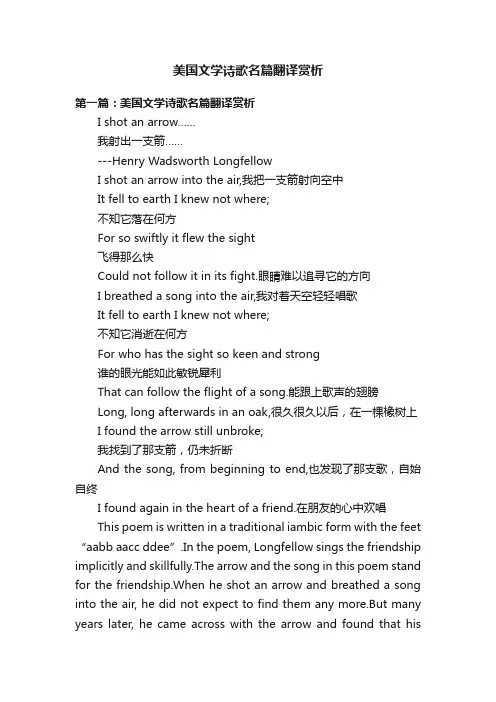
美国文学诗歌名篇翻译赏析第一篇:美国文学诗歌名篇翻译赏析I shot an arrow……我射出一支箭……---Henry Wadsworth LongfellowI shot an arrow into the air,我把一支箭射向空中It fell to earth I knew not where;不知它落在何方For so swiftly it flew the sight飞得那么快Could not follow it in its fight.眼睛难以追寻它的方向I breathed a song into the air,我对着天空轻轻唱歌It fell to earth I knew not where;不知它消逝在何方For who has the sight so keen and strong谁的眼光能如此敏锐犀利That can follow the flight of a song.能跟上歌声的翅膀Long, long afterwards in an oak,很久很久以后,在一棵橡树上I found the arrow still unbroke;我找到了那支箭,仍未折断And the song, from beginning to end,也发现了那支歌,自始自终I found again in the heart of a friend.在朋友的心中欢唱This poem is written in a traditional iambic form with the feet “aabb aacc ddee”.In the poem, Longfellow sings the friendship implicitly and skillfully.The arrow and the song in this poem stand for the friendship.When he shot an arrow and breathed a song into the air, he did not expect to find them any more.But many years later, he came across with the arrow and found that hissong was always in the heart of his friend.This suggests that the friendship is everlasting.I’m Nobody!我是无名之辈Emily DickinsonI’m nobody!Who are you?我是无名之辈!你是谁?Are you nobody, too?你也是无名之辈吗?Then there’s a pair of us----don’t tell!那么我们就是一对儿了!千万不要透露出去They’d banish us, you know!不然我们都会被他们驱逐,你知道。
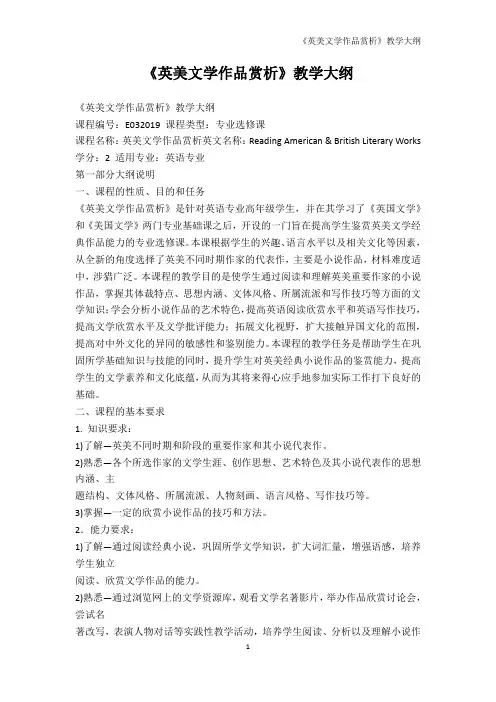
《英美文学作品赏析》教学大纲《英美文学作品赏析》教学大纲课程编号:E032019 课程类型:专业选修课课程名称:英美文学作品赏析英文名称:Reading American & British Literary Works 学分:2 适用专业:英语专业第一部分大纲说明一、课程的性质、目的和任务《英美文学作品赏析》是针对英语专业高年级学生,并在其学习了《英国文学》和《美国文学》两门专业基础课之后,开设的一门旨在提高学生鉴赏英美文学经典作品能力的专业选修课。
本课根据学生的兴趣、语言水平以及相关文化等因素,从全新的角度选择了英美不同时期作家的代表作,主要是小说作品,材料难度适中,涉猎广泛。
本课程的教学目的是使学生通过阅读和理解英美重要作家的小说作品,掌握其体裁特点、思想内涵、文体风格、所属流派和写作技巧等方面的文学知识;学会分析小说作品的艺术特色,提高英语阅读欣赏水平和英语写作技巧,提高文学欣赏水平及文学批评能力;拓展文化视野,扩大接触异国文化的范围,提高对中外文化的异同的敏感性和鉴别能力。
本课程的教学任务是帮助学生在巩固所学基础知识与技能的同时,提升学生对英美经典小说作品的鉴赏能力,提高学生的文学素养和文化底蕴,从而为其将来得心应手地参加实际工作打下良好的基础。
二、课程的基本要求1. 知识要求:1)了解—英美不同时期和阶段的重要作家和其小说代表作。
2)熟悉—各个所选作家的文学生涯、创作思想、艺术特色及其小说代表作的思想内涵、主题结构、文体风格、所属流派、人物刻画、语言风格、写作技巧等。
3)掌握—一定的欣赏小说作品的技巧和方法。
2.能力要求:1)了解—通过阅读经典小说,巩固所学文学知识,扩大词汇量,增强语感,培养学生独立阅读、欣赏文学作品的能力。
2)熟悉—通过浏览网上的文学资源库,观看文学名著影片,举办作品欣赏讨论会,尝试名著改写,表演人物对话等实践性教学活动,培养学生阅读、分析以及理解小说作赏能力、思辨能力和文学批判能力。
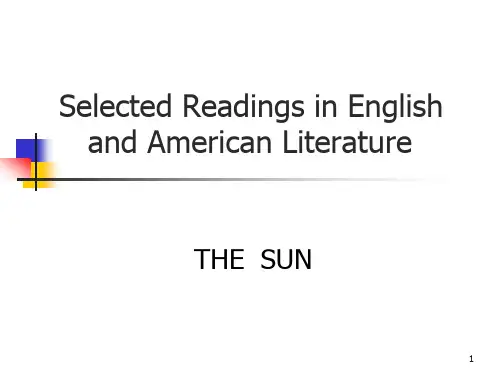

Ezra Pound (埃兹拉▪庞德)In a Station of the MetroThe apparition of these faces in the crowd;人群中这些面孔幽灵般闪现Petals on a wet,black bough.湿漉漉的黑色枝条上的众多花瓣1. Why does the poet call the faces of pedestrians "apparition"?These pedestrians are all walking in a hurry amidst the drizzling rain.2.What do "petals" and "bough" stand for?Petals refer to the faces while the bough stands for the floating crowd.Robert Frost(1)Fire and IceSome say the world will end in fire,有人说世界将终结于火,Some say in ice.有人说是冰。
From what I’ve tasted of desire,从我尝过的欲望之果I hold with those who favor fire.我赞同倾向于火之说。
But if it had to perish twice,但若它非得两度沉沦I think I know enough of hate.我想我对仇恨了解也够多To know that for destruction ice可以说要是去毁灭,Is also great 冰也不错,And would suffice.应该也行。
1. What are the symbolic meanings of fire in this poem?Fire symbolizes natural disaster, human passion, as well as war.2.Why does the speaker say that ice is also great for destruction? Explain what ice stands for here.Ice, oppose to fire, is also a dreadful natural disaster in this world, and ice is always related to indifference, coldness, hatred, and the other negative sentiments of human beings.3. What is your opinion about fire and ice? Which one is more destructive?Both fire and ice can destroy this beautiful world if they are beyond control of human beings. Therefore we should be open-minded and reduce our prejudice and pride so as to keep this world in peace.(2)Stopping By Woods On a Snowy Evening1. In your opinion, what was the reason that made the speaker stop by the woods on a snowy evening?The poet was deeply attracted by the natural beauty of the scene at that very moment.2.Why did the horse give the harness bell a shake?The horse grew impatient by stopping in the middle of the dark, cold woods at midnight. It was eager to go home.3.Why couldn't the speaker stay longer by the woods to appreciate its mysterious beauty?He realized that it was late at night and he would have to hurry home to get some food and sleep, because the next morning he would have a lot of work to do.4. What is the effect of repetition in the last two lines?The refrain-like repetition in the last two lines reminds the reader a simple fact of life: whatever happens, one must go forward in the journey of his or her life.5 stanza,16lines,Rhyme(押韵格式):aaba bbcb ccdc dddd翻译:Whose woods these are I think I know 我知道林子的主人是谁,His house is in the village though.虽村落是他所居之地。
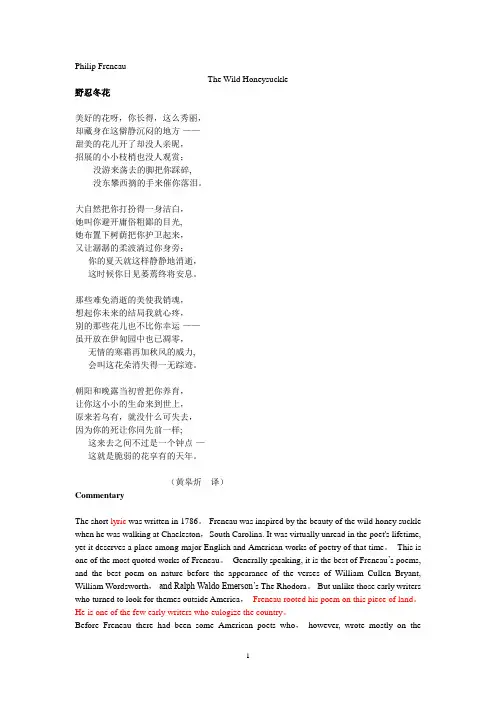
Philip FreneauThe Wild Honeysuckle野忍冬花美好的花呀,你长得,这么秀丽,却藏身在这僻静沉闷的地方-——甜美的花儿开了却没人亲昵,招展的小小枝梢也没人观赏;没游来荡去的脚把你踩碎,没东攀西摘的手来催你落泪。
大自然把你打扮得一身洁白,她叫你避开庸俗粗鄙的目光,她布置下树荫把你护卫起来,又让潺潺的柔波淌过你身旁;你的夏天就这样静静地消逝,这时候你日见萎蔫终将安息。
那些难免消逝的美使我销魂,想起你未来的结局我就心疼,别的那些花儿也不比你幸运-——虽开放在伊甸园中也已凋零,无情的寒霜再加秋风的威力,会叫这花朵消失得一无踪迹。
朝阳和晚露当初曾把你养育,让你这小小的生命来到世上,原来若乌有,就没什么可失去,因为你的死让你同先前一样;这来去之间不过是一个钟点-—-这就是脆弱的花享有的天年。
(黄皋炘译)CommentaryThe short lyric was written in 1786。
Freneau was inspired by the beauty of the wild honey suckle when he was walking at Chaeleston,South Carolina. It was virtually unread in the poet's lifetime, yet it deserves a place among major English and American works of poetry of that time。
This is one of the most quoted works of Freneau。
Generally speaking, it is the best of Freneau’s poems, and the best poem on nature before the appearance of the verses of William Cullen Bryant, William Wordsworth,and Ralph Waldo Emerson’s The Rhodora。
The Cask of AmontilladoIronically, the story takes place during the carnival season of madness and merrymaking. Montresor plays on Fortunato's pride in his wine connoisseurship, asking him to verify whether or not Montresor's recent bargain-price wine purchase is expensive amontillado or ordinary sherry. Fortunato agrees over Montresor's protests that it would be an imposition and a health danger, since the vaults where the wine is stored are cold, damp and "encrusted with nitre." Montresor's expressed concern for the other man's well-being is at odds with his true intentions.the names of the wines noted throughout the story and their possible symbolism. for example, "medoc" for fortunato so he can fend off the cold and "de grave" while he is walking to his own grave.There are four possible reasons why Fortunato volunteered to check if it were really Amontillado.1) He was drunk. 2) The festival was going on and he was in high spirits. 3) He wanted to prove that he was better than Luchesi. 4) He was, of course, tricked by Montresor. He put in much exaggeration and falsity into his 'speech' to egg Fortunado into entering the crypt or he would never be able to exact revenge."Free Mason refrence" When Montressor was talking about "being" a mason he was probably responding in scarcasim to Fortunato's question. Montressor cleverly knows that he is detering the attention of his drunkin friend when he pulls out his trowel (which is a tool for masony).At that point in the conversation it seems that Fortundo aknowledges he lost the conversation in his intoxication and moves along to the Amontillado.the abnormal social phenomena exist in the reality,the intrigue among people to gain profits and also the immoral measures people took for panning gold at the Gold Rush Era.The Celebrated Jumping Frog of Calaveras CountyPlot:The narrator is sent by a friend on an errand to visit an old man, Simon Wheeler, to find an old acquaintance of his friend, Leonidas W. Smiley. The narrator finds Simon at the "decayed mining camp of Angel's" The narrator asks the fat, bald-headed man of Leonidas. Simon responds that he doesn't know a Leonidas Smiley, but he knows of a Jim Smiley. From there Simon tells the story of Jim.Themes: A cultured Easterner relates his recent visit to a talkative old man at a western mining camp. Rather than providing information that the Easterner is looking for, the old man keeps him waiting while he spins a tale about a betting man and his pet frog.Culture Clash: it highlights various aspects of late nineteenth-century American society and culture through the retelling of a tall tale. Central to the story is the idea of conflicting cultures, particularly the clash between the settled, eastern portion of the United States and the still-developing West. At the time Twain wrote the story, the East and its inhabitants had a reputation for being civilized, cultured, and advanced. The West, on the other hand, was still being settled and was considered to be populated.Style:The frame tale structure.In a frame tale, one story appears in—that is, it is framed by—another story. In "Jumping Frog" the outer tale focuses on Mark Twain and his meeting with the talkative old storyteller, Simon Wheeler. This meeting occurs at the request of a friend of Twain's, identified in some versions of the tale as A. Ward, who supposedly wants to find out about an old acquaintance named Leonidas Smiley. Twain reveals, however, that he suspects his friend's request was merely a practical joke designed to waste his time. Twain's suspicions about the meeting and his descriptions of Wheeler appear in the few paragraphs that open and close the entire story.幽默艺术的四个特点:用夸张的手法突出幽默对象的本质特征;用漫画的技巧追求幽默艺术的深刻性;运用大量土语和俚语增强幽默效果;巧妙地构思出一些奇特、曲折的故事情节,增强幽默的感染力.A Clean,Well-Lighted PlaceThe old man is afraid of the darkness and loneliness, He need cafe's whiskey to encourage himself to live, to insist. The cafe represents the soul shelter or the rest harbor for the two.One man's loneliness and isolation from the rest of the world. the younger waiter and the older one are different. The older one has more xp in the world, so he can understand the old man better. Nothingness is the keynote of the whole story.In the end, Hemingway leaves us with an universality to the tale in that: "Many must have it." Not only do many people have the insomnia and sleeplessness, but they also experience loneliness and the need for a clean, well-lighted place in which to feel safe, or perhaps insulated.Some have argued that Hemingway contrasts light and shadow to differentiate the old man and the young people around him, and uses the deafness of the old man as a symbol for his separation from the rest of the world. Hemingway uses the waiters to judge the old man and portray his views. As a clean drunk, the man does not spill a drop as he drinks and walks "unsteadily but with dignity" when he finally leaves the café. The waiters talkbetween themselves as the young waiter asks the old waiter the man’s story. He wond ers how anyone could sit alone drinking in the café instead of buying a bottle for himself and drink in the comfort of his own home. It is then the old waiter who defends the man. The old waiter acknowledges that it is better for the man to have many drinks in public than any drinks in private.Another way to analyze the relationships between the men is to compare them as one person. The young waiter complains about having to stick around the café waiting for the man to finish drinking. He claims that he has a wife to go home to and he would rather be in bed than in the café. The old waiter defends the drinking man because he can relate and even see himself in the man. He sympathizes knowing that he, too, prefers a clean well lighted place to drink and will later appreciate such a place in his old drinking age. The old man is in his final years of life and the old waiter recognizes that he soon will have the same fate as the old man. A progression of age is seen among the characters demonstrating the transition from being young and social to aging and feeling lonely. Hemingway portrays a difference in age, experience, and opinion of drinking through the unique characters.虚无就是黑暗孤独,无希望、无意义、精神无所寄托的迷惘。
1. Analyze the poem “The Wild Honey Suckle”Understand the title: 1.The name honeysuckle comes from the sweet nectar that the flower produces to intoxicate the greedy bee. Its powerful fragrance seduces the human senses as it pervades the air. The perfume o f this passionate plant may turn a maiden’s head, hence wild honeysuckle is a symbol of inconstancy in love.2. The word “wild” implies her living place; she lives in wilderness not in paradise or house; so she will not be appreciated by others and feels sorrowful. Also it implies the nature, so we can say the writer is describing the nature.2. Analyze Whitman’s “Song of Myself” (Over 200 words)"Song of Myself" is all about the human experience. The human experience, here, means what men of the past, present and future have seen, touched, smelt, and heard. In this poem Whitman is explaining how all of humanity is like one living organism, and no one part is more important than the other. In section 44 of "Song of Myself" Whitman says, "We have thus far exhausted trillions of winters and summers, There are trillions ahead, and trillions ahead of them. Births have brought us richness and variety, And other births will bring us richness and variety. I do not call one greater and one smaller, That which fills its period and place is equal to any." It is clear that Whitman had a perspective of the human race and its history that escaped most writers. More specifically, Whitman speaks of equal contribution to the human experience in section 42: "Here and there with dimes on the eyes walking, To feed the greed of the belly the brains liberally spooning, Tickets buying, taking, selling, but in to the feast never once going, Many sweating, ploughing, thrashing, and then the chaff for payment receiving, A few idly owning, and they the wheat continually claiming. This is the city and I am one of the citizens, Whatever interests the rest interests me, politics, wars, markets, newspapers, schools, The mayor and councils, banks, tariffs, steamships, factories, stocks, stores, real estate and personal estate. 3. Emily’s “Because I Could Not Stop for Death” (Over 300 words)The poem begins with a leisurely image. At first, the protagonist feels totally at ease and the usually frightening death is described as if a familiar friend, gentle and polite. Continuingly, the poem is developed upon a basic metaphor that life is a journey. It was truly rather old a comparison, but Dickinson enriched it with her creativity and imagination: "School, where Children strove" --childhood; "Fields of Gazing Grain"--maturity; and "Setting Sun"--old age. Then “the Dews drew quivering and chill-” makes the protagonist feel terribly cold, which may mean that they are getting nearer and nearer to the tomb. But at last, his companions, Immortality and Death, finally desert him and leave him alone to go toward Eternity.So it seems that though death cheats him and at the same time deserts him, the experience of death itself is not painful. Emily Dickinson’s poems just explain this kind of essence of life, which then lead you to a world of imagination and thinking.4. Appreciate the poem “In a Station of the Metro”.The poem is essentially a set of images that have unexpected likeness and convey the rare emotion that Pound was experiencing at that time. Arguably the heart of the poem is not the first line, nor the second, but the mental process that links the two together. "In a poem ofthis sort," as Pound explained, "one is trying to record the precise instant when a thing outward and objective transforms itself, or darts into a thing inward and subjective." This darting takes place between the first and second lines. The pivotal semi-colon has stirred debate as to whether the first line is in fact subordinate to the second or both lines are of equal, independent importance. Pound contrasts the factual, mundane image that he actually witnessed with a metaphor from nature and thus infuses this “apparition” with visual beauty. There is a quick transition from the statement of the first line to the second line’s vivid metaphor; this ‘super-pository’ technique exemplifies the Japanese haiku style. The word “apparition” is considered crucial as it evokes a mystical and supernatural sense of imprecision which is then reinforced by the metaphor of the second line. The plosive word ‘Petals’ conjures ideas of delicate, feminine beauty which contrasts with the bleakness of the ‘wet, black bough’. What the poem signifies is questionable; many critics argue that it deliberately transcends traditional form and therefore its meaning is solely found in its technique as opposed to in its content. However when Pound had the inspiration to write this poem few of these considerations came into view. He simply wished to translate his perception of beauty in the midst of ugliness into a single, perfect image in written form.It is also worth noting that the number of words in the poem (fourteen) is the same as the number of lines in a sonnet. The words are distributed with eight in the first line and six in the second, mirroring the octet-sestet form of the Italian (or Petrarchan) sonnet.5. Appreciate the poem “Stopping by Woods on a Snow Evening”.“Stopping by Woods on a Snowy Evening,” like many of Frost's poems, explores the theme of the individual caught between nature and civilization. The speaker's location on the border between civilization and wilderness echoes a common theme throughout American literature. The speaker is drawn to the beauty and allure of the woods, which represent nature, but has obligations—“promises to keep”—which draw him away from nature and back to society and the world of men. The speaker is thus faced with a choice of whether to give in to the allure of nature, or remain in the realm of society. Some critics have interpreted the poem as a meditation on death—the woods represent the allure of death, perhaps suicide, which the speaker resists in order to return to the mundane tasks which order daily life.6. Analyze the poem “The Road Not Taken”.the poem is inspirational, a paean to individualism and non-conformism.The poem consists of four stanzas. In the first stanza, the speaker describes his position.He has been out walking in the woods and comes to two roads, and he stands looking as far down each one as he can see. He would like to try out both, but doubts he could do that, so therefore he continues to look down the roads for a long time trying to make his decision about which road to take. The ironic interpretation, widely held by critics, is that the poem is instead about regret and personal myth-making, rationalizing our decisions.In this interpretation, the final two lines:I took the one less traveled by,And that has made all the difference.are ironic : the choice made little or no difference at all, the speaker's protestations to the contrary. The speaker admits in the second and third stanzas that both paths may be equally worn and equally leaf-covered, and it is only in his future recollection that he will call one road "less traveled by".The sigh, widely interpreted as a sigh of regret, might also be interpreted ironically: in a 1925 letter to Cristine Yates of Dickson, Tennessee, asking about the sigh, Frost replied: "It was my rather private jest at the expense of those who might think I would yet live to be sorry for the way I had taken in life."7. Analyze the poem “Anecdote of the Jar”.This famous, much-anthologized poem succinctly accommodates a remarkable number of different and plausible interpretations, as Jacqueline Brogan observes in a discussion of how she teaches it to her students.It can be approached from a New Critical perspective as a poem about writing poetry and making art generally. From a poststructuralist perspective the poem is concerned with temporal and linguistic disjunction, especially in the convoluted syntax of the last two lines. A feminist perspective reveals a poem concerned with male dominance over a traditionally feminized landscape.A cultural critic might find a sense of industrial imperialism. Brogan concludes: "When thedebate gets particularly intense, I introduce Roy Harvey Pearce's discovery of the Dominion canning jars (a picture of which is then passed around)."8. Analyze T. S. Eliot’s “The Love Song of J. Alfred Prufrock”. (Over 500words)On the surface, "The Love Song of J. Alfred Prufrock" relays the thoughts of a sexually frustrated middle-aged man who wants to say something but is afraid to do so, and ultimately does not.The dispute, however, lies in to whom Prufrock is speaking, whether he is actually going anywhere, what he wants to say, and to what the various images refer.The intended audience is not evident. Some believe that Prufrock is talking to another person or directly to the reader, while others believe Prufrock's monologue is internal.Perrine writes "The 'you and I' of the first line are divided parts of Prufrock's own nature", while Mutlu Konuk Blasing suggests that the "you and I" refers to the relationship between the dilemmas of the character and the author. Similarly, critics dispute whether Prufrock is going somewhere during the course of the poem. In the first half of the poem, Prufrock uses various outdoor images (the sky, streets, cheap restaurants and hotels, fog), and talks about how there will be time for various things before "the taking of toast and tea", and "time to turn back and descend the stair." This has led many to believe that Prufrock is on his way to an afternoon tea, in which he is preparing to ask this "overwhelming question". Others, however, believe that Prufrock is not physically going anywhere, but rather, is playing through it in his mind.Perhaps the most significant dispute lies over the "overwhelming question" that Prufrock is trying to ask. Many believe that Prufrock is trying to tell a woman of his romantic interest in her, pointing to the various images of women's arms and clothing and the final few lines in which Prufrock laments that the mermaids will not sing to him. Others, however, believe that Prufrock is trying to express some deeper philosophical insight or disillusionment with society, but fears rejection, pointing to statements that express a disillusionment with society such as "I have measured out my life with coffee spoons" (line 51). Many believe that the poem is a criticism of Edwardian society and Prufrock's dilemma represents the inability to live a meaningful existence in the modern world. McCoy and Harlan wrote "Formany readers in the 1920s, Prufrock seemed to epitomize the frustration and impotence of the modern individual. He seemed to represent thwarted desires and modern disillusionment."As the poem uses the stream of consciousness technique, it is often difficult to determine what is meant to be interpreted literally or symbolically. In general, Eliot uses imagery which is indicative of Prufrock's character, representing aging and decay. For example, "When the evening is spread out against the sky / Like a patient etherized upon a table"(lines 2-3), the "sawdust restaurants" and "cheap hotels," the yellow fog, and the afternoon "Asleep...tired... or it malingers" (line 77), are reminiscent of languor and decay, while Prufrock's various concerns about his hair and teeth, as well as the mermaids "Combing the white hair of the waves blown back / When the wind blows the water white and black,"show his concern over aging.(注:文档可能无法思考全面,请浏览后下载,供参考。
1. The Soul Selects Her Own Society
The Soul selects her own Society---
Then---shuts the door---
To her divine Majority---
Present no more---
Unmoved ---she notes the Chariots---pausing---
At her low Gate---
Unmoved---an Emperor be kneeling
Upon her Mat---
I’ve known her---from an ample nation--- Choose One---
Then---close the Valves or her attention--- Like Stone---
1) the soul made its choice and wanted no more.
This showed her resolution and determination.
2) Unmoved by any other temptation
3) Since I have made my choice, I will stick to it
and will never be tempted by other things. Soul, one: art , poetry, love, ideal
2. Anecdote(奇闻,轶事) of the Jar
I placed a jar in Tennessee,
And round it was, upon a hill.
It made the slovenly wilderness
Surround that hill
The wilderness rose up to it,
And sprawled around, no longer wild.
The jar round upon the ground
And tall and of a port in air
It took dominion everywhere.
The jar was gray and bare.
It did not give of bird or bush
Like nothing else in Tennessee.
Interpretation:
the setting is the wild, chaotic and Tennessee, a symbol of the world of nature. Then “I” of the poem places in i8t a tall, round jar, a man-made object, a symbol of the world of art, and by extension, it controls the whole disorderly landscape, so that “The wilderness rose up to it, / And sprawled around , no longer wild.” The poem seems to talk about the relationship between art and nature. The world of nature, shapeless and slovenly, takes shape and order from the presence of the jar. The world of art and imagination gives form and meaning to that of nature and reality, this suggesting that any society without art is one without order and that man makes the order he perceives, and the world he inhabits is one he half creates
On the other hand the world of reality exists to determine the limits of art, and
imagination can construct only on the basis of the world of nature. Stevens manages to keep a balance between art and life in his creative work. It is true that the jar imposes order and form on the sprawling wilderness around, but the two concluding lines, “It did not give of bird or bush,/Like nothing else in Tennessee”, render the jar something dependent on the physical world as its “central reference.”。